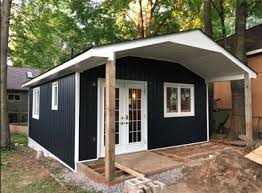Downspouts are an essential component of any home’s drainage system. They help channel rainwater from the roof and gutters down to the ground, preventing water from pooling around the foundation and causing potential damage. Over time, downspouts can become damaged, clogged, or ineffective, necessitating replacement. This article will guide you through the process of downspout replacement, covering everything from identification of the need for replacement to installation and maintenance tips.
1. Why Downspout Replacement is Necessary
Several factors can lead to the need for downspout replacement, including:
- Physical Damage: Heavy storms, ice, or debris can cause physical damage to downspouts, leading to cracks, dents, or separations.
- Clogging: Over time, leaves, twigs, and other debris can accumulate, causing clogs that hinder water flow. While cleaning might resolve minor clogs, severe blockages can damage the downspout or necessitate a complete replacement.
- Corrosion: Metal downspouts, particularly those made from galvanized steel, can corrode over time due to exposure to moisture and elements. This can lead to leaks and reduced effectiveness.
- Improper Installation: If the downspout was poorly installed or is incorrectly sized for the gutter system, it may not effectively direct water away from the foundation, leading to water damage.
2. Identifying the Need for Replacement
Before embarking on a downspout replacement project, it’s essential to assess the current condition of your downspouts. Here are some signs that replacement may be necessary:
- Visible Damage: Look for cracks, holes, or bent sections in the downspout.
- Water Pooling: If you notice water pooling around the foundation after heavy rain, it may indicate that your downspouts aren’t directing water away effectively.
- Rust or Corrosion: If you have metal downspouts, check for rust spots or corrosion, which can compromise their integrity.
- Separation: If the downspout is detached from the gutter or has gaps at the joints, it’s time for replacement.
3. Choosing the Right Replacement Downspout
When selecting a replacement downspout, consider the following factors:
- Material: Downspouts are typically made from vinyl, aluminum, steel, or copper. Each material has its pros and cons:
- Vinyl: Lightweight, affordable, and resistant to corrosion but can crack in extreme temperatures.
- Aluminum: Lightweight and resistant to rust but can dent easily.
- Steel: Strong and durable but prone to rust if not properly coated.
- Copper: Offers a distinctive look and longevity but is more expensive and requires specialized installation.
- Size: Ensure that the replacement downspout matches the size and style of your existing gutter system. Common sizes include 2x3 inches and 3x4 inches. The size will affect the downspout's capacity to handle rainwater.
- Color and Finish: If aesthetics are important, choose a color and finish that matches your home’s exterior. Many materials are available in various colors to complement your home’s design.
4. Tools and Materials Needed for Replacement
Before starting the replacement process, gather the necessary tools and materials:
Tools:
- Ladder
- Measuring tape
- Hacksaw or tin snips (for cutting metal)
- Drill and drill bits
- Screws and anchors
- Safety goggles and gloves
Materials:
- Replacement downspout
- Downspout brackets (if not included with the downspout)
- Elbows and fittings (if needed)
- Sealant or caulk (for sealing joints)
5. Step-by-Step Downspout Replacement Process
Step 1: Remove the Old Downspout
- Carefully climb the ladder and detach the old downspout from the gutter and the ground.
- Use a drill or screwdriver to remove any screws or brackets holding it in place.
- If the downspout is stuck due to corrosion or debris, gently wiggle it free.
Step 2: Measure and Cut the New Downspout
- Measure the length needed for the new downspout, ensuring it fits properly from the gutter to the ground.
- Use a hacksaw or tin snips to cut the downspout to the desired length, ensuring clean and straight cuts.
Step 3: Install the New Downspout
- Attach the new downspout to the existing gutter. Ensure it fits snugly into the outlet and secure it with screws or brackets.
- If the downspout requires elbows or fittings, attach them as needed to direct water properly.
Step 4: Secure the Downspout to the Wall
- Use downspout brackets to secure the downspout to the wall of your home, preventing movement during heavy rain or wind. Install the brackets at regular intervals for added support.
Step 5: Connect to the Drainage System
- Ensure the bottom of the downspout is directed away from the foundation. If necessary, connect it to an underground drainage system or splash block to further direct water away from the house.
Step 6: Seal Any Joints
- Apply sealant or caulk to any joints or connections to prevent leaks and ensure a watertight fit.
6. Maintenance Tips for Downspouts
Once your new downspout is installed, regular maintenance is crucial for its longevity and effectiveness:
- Clean Regularly: Check for clogs and debris in the downspout regularly, especially during and after heavy storms. Clear out any leaves or twigs that may obstruct water flow.
- Inspect for Damage: Periodically inspect the downspout for signs of damage, rust, or separation, addressing any issues promptly.
- Check the Drainage: After heavy rain, ensure that water is being directed away from the foundation and that there are no pooling issues.
Conclusion
Replacing a downspout may seem like a minor task, but it plays a vital role in protecting your home from water damage. By recognizing the signs of damage and knowing when to replace your downspouts, you can maintain an effective drainage system that safeguards your foundation. With the right materials and proper installation techniques, you can ensure that your downspouts continue to direct water away from your home for years to come. Regular maintenance will further enhance their effectiveness, providing peace of mind during heavy rainstorms. Whether you choose to tackle the replacement yourself or hire a professional, understanding the process will help you make informed decisions for your home’s upkeep.





Comments